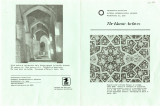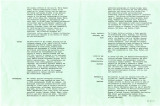| OCR Text |
Show The Islamic Archives of the late Dr. Myron Bement Smith, formerly administered jointly by the Committee for Islamic Culture and the Committee for Arabic and Islamic Studies of the American Council of Learned Societies, is now in the custody of the National Anthropological Archives. A gift of his widow, Mrs. Katharine Dennis Smith, the collection consists of approximately 100 cubic feet, or 87,000 items, including professional and personal papers, photographic negatives and prints, color and lantern slides, architectural sketches, drawings, plans, and maps assembled by Dr. Smith during his forty-year career as a classical archeologist, architect, and art historian. The collection documents and illustrates various aspects of Islamic civilization, with particular emphasis on the history of Islamic art and architecture. PAPERS The main papers in the Islamic Archives are the fieldwork reports of Dr. Smith's 1927-28 Italian expedition and 1933-37 Iranian expedition, supplemented by field notes, architectural drawings and photographs of Italian brickwork and Iranian architecture and decorative arts. Also included are correspondence and other records of Smith's research between 1959 and 1970 that resulted in reports to the Department of Health, Education, and Welfare, to a special joint UNESCO-Iranian Government program, and to similar organizations. The correspondence and reference files (bibliographies, extracts, clippings, and scholarly reprints) enhance the collection. There are additional materials on the history of the Islamic Archives, Smith's lecture tours of American universities and Islamic countries as well as his frequent participation in various scholarly meetings and international congresses. PHOTOGRAPHS The Islamic Archives photograph collection contains 64,000 items spanning the years 1925 to 1969; approximately 20,000 are indexed. The photograph collection provides effective visual coverage of a wide range of subjects related to the anthropology, archeology, architecture, art, geography, and history of the Islamic world- India, Afghanistan, Iran, Iraq, Syria, the Arabian peninsula, Jordan, Lebanon, Turkey, Egypt, Libya, Morocco, and other states and areas. Additional photodocuments of special interest are Smith's exhibition photographs of Iranian Islamic monuments and their decoration and also photoprints, negatives, and lantern and color slides from more than fifty private and institutional collections acquired through purchase or individual deposit. The private collections represented are those of Josephine Powell, Ernst Herzfeld, Henry Field, Kenneth Scott, Carlton Coon, William 0. Douglas, Sir Keppel Archibald Carmen Cresswell, and others. Approximately 3,000 color transparencies are arranged for classroom use to illustrate such specific topics as Alhambra, the Hajj, minarets, mosques, Taj Mahal, and Masjid-i Shah. PLANS, DRAWINGS, SKETCHES, AND MAPS The Islamic Archives contains a large quantity of architectural plans, drawings, and sketches, most of which depict Iranian monuments, particularly the Masjid-i Jum'a at Isfahan, covered by the fieldwork report of Dr. Smith's 1933-37 Iranian expedition. Also included are graphic materials reflecting Islamic influence on Italian architecture collected earlier. There are approximately 1,300 maps, ranging from general maps of broad geographic coverage to specialized maps that concentrate on Iran, Iraq, Turkey, and Egypt. GIFTS TO THE NATIONAL ANTHROPOLOGICAL ARCHIVES To assist its work, the National Anthropological Archives welcomes financial donations and gifts of private papers and photographic materials relating to Islamic studies. The Archives will prepare for the donor's signature a formal instrument of gift embodying reasonable restrictions that the donor may wish to impose. Instructions for the shipment of papers, at the expense of the National Anthropological Archives , will be sent upon application. RESEARCH AT The Archives is open for research from 9:00 a.m. THE to 5:00 p.m., Monday through Friday, national holidays excepted. Since the material in the ARCHIVES Islamic Archives is diverse and access to some of the resources is restricted, it is advisable to notify the Archives well in advance of a visit and to obtain information about the use of specific material. The address is National Anthropological Archives, Department of Anthropology, National Museum of Natural History, Smithsonian Institution, 10th Street and Constitution Avenue, N.W., Washington, D.C. 20560. The telephone number is (202) 381-5225. GPO 881-727 |






